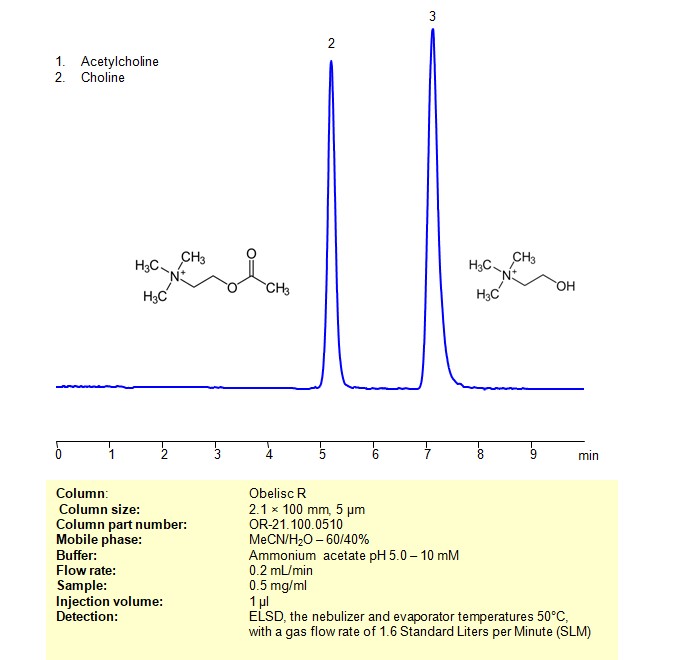HPLC Method for Analysis of Acetylcholine, Choline on Obelisc R by SIELC Technologies

High Performance Liquid Chromatography (HPLC) Method for Analysis of Acetylcholine, Choline
Acetylcholine and choline are related compounds that play distinct roles in the body, particularly in the nervous system.
- Choline:
- Definition: Choline is an essential nutrient that belongs to the B-vitamin complex.
- Chemical Structure: Choline is a quaternary ammonium salt containing a positively charged nitrogen atom and is often written as (N(CH_3)_3^+).
- Function: Choline serves as a precursor for the synthesis of various important molecules, including phospholipids (essential components of cell membranes) and the neurotransmitter acetylcholine. Choline is crucial for maintaining cell membrane integrity and is involved in liver function.
- Dietary Sources: Choline is found in foods such as eggs, meat, fish, nuts, and certain vegetables. It can also be consumed as a dietary supplement.
- Acetylcholine:
- Definition: Acetylcholine is a neurotransmitter, which is a chemical messenger that transmits signals between nerve cells (neurons) or from neurons to muscles.
- Chemical Structure: Acetylcholine is derived from the combination of choline and acetyl coenzyme A. Its chemical formula is (CH_3COOCH_2CH_2N(CH_3)_3^+).
- Function: Acetylcholine plays a crucial role in transmitting signals across synapses, including those between neurons and muscles (neuromuscular junctions). It is involved in muscle contraction, autonomic nervous system functions, and cognitive processes such as memory and learning.
- Synthesis and Release: Acetylcholine is synthesized within nerve cells and released into synapses upon a nerve impulse. Its action is terminated by the enzyme acetylcholinesterase, which breaks it down in the synaptic cleft.
In summary, choline is a nutrient that the body uses to synthesize acetylcholine, among other important molecules. Acetylcholine, on the other hand, is a neurotransmitter responsible for transmitting signals in the nervous system. While choline is obtained from the diet or supplements, acetylcholine is a key mediator of nerve and muscle function in the body.
Acetylcholine and Choline can be retained, separated and analyzed using an Obelisc R mixed-mode stationary phase column. The analysis employs an isocratic method with a simple mobile phase consisting of water, acetonitrile (MeCN), and ammonium acetate as a buffer. Detection is achieved using ELSD
| Column | Obelisc R, 2.1 x 100 mm, 5 µm, 100 A, dual ended |
| Mobile Phase | MeCN/H2O – 60/40% |
| Buffer | Ammonium acetate pH 5.0 – 10 mM |
| Flow Rate | 0.2 ml/min |
| Detection | ELSD, the nebulizer and evaporator temperatures 50°C, with a gas flow rate of 1.6 Standard Liters per Minute (SLM) |
| Samples | 0.5 mg/ml |
| Injection volume | 1 µl |
| LOD* | 200 ppb |
| Class of Compounds | Quaternity amines |
| Analyzing Compounds | Acetylcholine, Choline |
Application Column
Obelisc R
Column Diameter: 2.1 mm
Column Length: 100 mm
Particle Size: 5 µm
Pore Size: 100 A
Column options: dual ended
Choline





